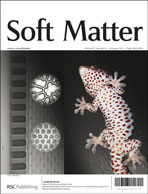Effect of a non-volatile cosolvent on crack patterns induced by desiccation of a colloidal gel
Abstract
The consolidation of colloidal gels results in enormous stresses that are usually released by the formation of undesirable cracks. The capacity of a gel network to crack during drying depends on the existence and significance of a pressure gradient in the pore liquid; in addition it depends on the way the gel relaxes the resulting drying stresses. In this paper the effect of a binary mixture of


 Please wait while we load your content...
Please wait while we load your content...